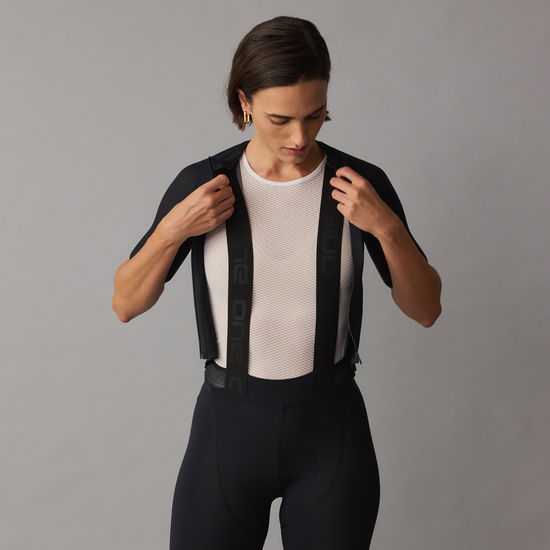Ride further. Feel better.
The SQlab chamois pads are designed to deliver maximum function with minimal thickness. Developed using lab-based pressure analysis, they offer targeted pressure relief and high efficiency – without bulk and without compromising comfort or freedom of movement.
Less padding. More performance.
Slim & firm: Just 4–8 mm thick for optimal support without bulk
Unisex design: One shape fits all – built around pressure relief, not gender
Advanced foam tech: High breathability and comfort in a compact form
Shear Force protection: TPE gel layer reduces friction and skin irritation
Our approach vs. bulky traditional pads
The SQ-Pads are designed with a slim profile, ranging from just 4 to 8 mm in thickness, offering a firm, high-quality feel. While many pads on the market opt for thick, soft cushioning, SQlab focuses on a minimalist, performance-driven approach. This ensures that the pads provide excellent support without unnecessary bulk. On long rides, SQ-Pads maintain their shape, unlike thicker, softer pads that can compress and shift uncomfortably during pedaling. SQlab’s design eliminates the common issue of pads pushing inward, offering consistent comfort and stability, ride after ride. Thanks to the thin yet highly effective damping layer, our firm, slim design ensures a more efficient and comfortable ride—without compromising on performance.
Using pressure mapping technology and thousands of test kilometers, SQlab pads have been proven to reduce peak pressure, friction, and unwanted movement.
The result: better blood flow, more stability, and more comfort – even on long rides.
:grayscale(false):quality(10):blur(20))
Innovating what others won't
:grayscale(false):quality(10):blur(20))
Overly soft saddles and pads cause the ischial bones to sink, increasing pressure on sensitive areas like the perineum for men and the pelvic region for women. SQlab’s firm, ergonomic pads provide proper support, improving blood flow and reducing friction. The result? The pad is equally suitable for men and women, as the requirements for pressure relief are similar, and the pelvic structure is nearly identical.
High quality foams with superior cushioning properties typically have a higher density, which results in reduced breathability. This is why many traditional pads are either bulky or soft but lack the ability to properly regulate temperature and moisture. Thanks to a patented process, we have been able to break up the structure of these dense foams, achieving a unique combination of high breathability compared to conventional pads – while maintaining exceptional damping properties. This innovation allows for a thinner, firmer pad without comfort performance.
Shear Forces vs. TPE Gel
 Saddle pain is often caused by shear forces from subtle pelvic movement during pedaling, leading to discomfort and skin irritation. Shear forces occur wherever skin layers shift against each other, leading to micro tears within the tissue. The new SQ-Pads 10, 11 and 14 feature a thin layer of orthopedic TPE gel that effectively absorbs these forces, minimizing friction and reducing the risk of chafing.
Saddle pain is often caused by shear forces from subtle pelvic movement during pedaling, leading to discomfort and skin irritation. Shear forces occur wherever skin layers shift against each other, leading to micro tears within the tissue. The new SQ-Pads 10, 11 and 14 feature a thin layer of orthopedic TPE gel that effectively absorbs these forces, minimizing friction and reducing the risk of chafing.
The graphic shows how SQlab’s orthopedic TPE gel responds to shear forces. Center: At rest – the gel remains stable. Left & right: Under pedaling motion – the gel deforms in opposing directions to absorb shear, reducing skin irritation and discomfort.
:grayscale(false):quality(10):blur(20))
Lab Insights
:grayscale(false):quality(10):blur(20))
At SQlab, we rely on precise pressure mapping to optimize comfort and performance. A pressure-sensitive film with over 100 sensors is placed on the saddle. When the rider sits, the sensors measure the pressure distribution and transmit the data wirelessly to a computer. Measurements can be taken either statically in the lab on a trainer or dynamically during a ride. The pressure distribution is displayed in a color-coded format:
Blue: Low pressure
Turquoise to red: Increasing pressure
Pressure Mapping
The displayed pressure mapping images compare measurements taken on a saddle without padding to those taken with the respective SQ-Pad. The images clearly demonstrate how the pads effectively reduce pressure while perfectly adapting to the riding position specific to each riding position.
SQlab Study (2017)
The SQ-Pad 12 reduces vertical force by 26.97 % compared to the saddle shell. In contrast, traditional pads reduce vertical force by only 1 % to 5 %.
The displayed pressure mapping images compare measurements taken on a standard OEM saddle:
without padding
with a standard pad
with the SQ-Pad 11
The images clearly show that the standard pad, with a supposedly comfortable thickness of 16 mm, has hardly any effect on pressure relief. In contrast, the SQ-Pad 11 can significantly reduce the pressure even with a standard saddle.
In figures:
The standard pad reduces peak average pressure by 9.5 % compared to the pressure measurement without a pad. The SQ-Pad 11 reduces the peak average pressure by 49.7 %.
Conclusion: The SQ-Pad makes every saddle better.
Color scale:
Blue: Low pressure
Red: High pressure
:grayscale(false):quality(10):blur(20))
Still need advice? Ask us directly for personal support
If you still aren't sure about how to find your perfect matching products, don't hesitate to call our customer support or to write us through the contact form. You can also have a look at our FAQ or visit a specialist retailer near to your location.
:grayscale(false):quality(10):blur(20))
:grayscale(false):quality(10):blur(20))
:grayscale(false):quality(10):blur(20))
:grayscale(false):quality(10):blur(20))
:grayscale(false):quality(10):blur(20))
:grayscale(false):quality(10):blur(20))
:grayscale(false):quality(10):blur(20))
:grayscale(false):quality(10):blur(20))
:grayscale(false):quality(10):blur(20))
:grayscale(false):quality(10):blur(20))
:grayscale(false):quality(10):blur(20))
:grayscale(false):quality(10):blur(20))
:grayscale(false):quality(10):blur(20))
:grayscale(false):quality(10):blur(20))
:grayscale(false):quality(10):blur(20))
:grayscale(false):quality(10):blur(20))












:grayscale(false):quality(10):blur(20))